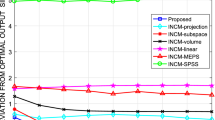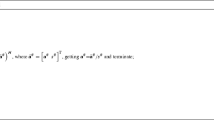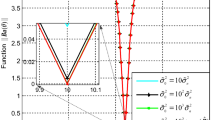Abstract
To address the issue of steering vector mismatch, a robust adaptive beamforming design via steering vector optimization is proposed in this paper. Different from conventional studies, this paper resolves the exact desired signal (DS) steering vector through formulating an array output power maximization problem subjected to noise subspace (NS) based and interference subspace (IS) based constraints. Under the condition that the NS is ready to be attained while the IS is hard to be got, two efficient interference-plus-noise covariance matrix (INCM) reconstruction means, i.e. direct DS matrix removal from sample covariance matrix and indirect DS blocking from training data and matrix transition, are derived to estimate the IS with high accuracy. Herein, after resolving DS steering vector, the weight vectors are thereby extracted with orthogonal projection (OP) criterion. Numerical simulations verify that the devised methods can outperform the existing ones and obtain almost optimal performance across a wide range of DS power.









Similar content being viewed by others
References
Capon, J. (1969). High-resolution frequency wave number spectrum analysis. Proceedings of the IEEE, 57(8), 1408–1418.
Du, L., Li, J., & Stoica, P. (2010). Fully automatic computation of diagonal loading levels for robust adaptive beamforming. IEEE Transactions on Aerospace and Electronic Systems, 46(1), 449–458.
Fabrizio, G. A., Gray, D. A., & Turkey, M. D. (2003). Experimental evaluation of adaptive beamforming methods and interference methods for high frequency over-the-horizon radar systems. Muldim. Syst. Signal Process., 14(1–3), 241–263.
Feldman, D. D., & Griffiths, L. J. (1994). A projection approach for robust adaptive beamforming. IEEE Transactions on Signal Processing, 42(4), 867–876.
Grant, M., Boyd, S., and Ye, Y. (2014). CVX: Matlab software for disciplined convex programming, [online], Available: < http://cvxr.com/cvx/>. June
Gu, Y. J., & Leshem, A. (2012). Robust adaptive beamforming based on interference covariance matrix reconstruction and steering vector estimation. IEEE Transactions on Signal Processing, 60(7), 3881–3885.
Hassanien, A., Vorobyov, S. A., & Wong, K. M. (2008). Robust adaptive beamforming using sequential programming: An iterative solution to the mismatch problem. IEEE Signal Processings Letters, 15, 733–736.
Huang, F., Sheng, W., & Ma, X. (2012). Modified projection approach for robust adaptive array beamforming. Signal Process., 92(7), 1758–1763.
Huang, L., Zhang, J., Xu, X., et al. (2015). Robust adaptive beamforming with a novel interference-plus-noise covariance matrix reconstruction method. IEEE Transactions on Signal Processing, 63(7), 1643–1650.
Khabbazibasmenj, A., Vorobyov, S. A., & Hassanien, A. (2012). Robust adaptive beamforming based on steering vector estimation with as little as possible prior information. IEEE Transaction on Signal Processings, 60(6), 2974–2987.
Li, J., Stoica, P., & Wang, Z. (2003). On robust Capon beamforming and diagonal loading. IEEE Transactions on Signal Processing, 51(7), 1702–1715.
Li, Z. H., Zhang, Y. S., Ge, Q. C., et al. (2019). Middle subarray interference covariance matrix reconstruction approach for robust adaptive beamforming with mutual coupling. IEEE Communications Letters, 23(4), 664–667.
Lie, J. P., Ser, W., & See, C. M. S. (2011). Adaptive uncertainty based iterative robust Capon beamformer using steering vector mismatch estimation. IEEE Transactions on Signal Processing, 59(9), 4483–4488.
Lorenz, R., & Boyed, S. P. (2005). Robust minimum variance beamforming. IEEE Transactions on Signal Processing, 53(5), 1684–1696.
Mestre, X., & Lagunas, M. A. (2006). Finite sample size effect on minimum variance beamformers: optimum diagonal loading factor for large arrays. IEEE Transactions on Signal Processing, 54(1), 69–82.
Reed, S., Mallett, J. D., & Brennan, L. E. (1974). Rapid convergence rate in adaptive arrays. IEEE Transactions on Aerospace and Electronic Systems, 10(6), 853–863.
Ruan, H., & de Lamare, R. C. (2014). Robust adaptive beamforming using a low-complexity shrinkage-based mismatch estimation algorithm. IEEE Signal Processing Letters, 21(1), 60–64.
Schmidt, R. O. (1986). Multiple emitter location and signal parameter estimation. IEEE Transactions on Antennas and Propagation, 34(3), 276–280.
Shahbazpanahi, S., Gershman, A. B., Luo, Z. Q., et al. (2003). Robust adaptive beamforming for general-rank signal models. IEEE Transactions on Signal Processing, 51(9), 2257–2269.
Stoica, P., Wang, Z., & Li, J. (2003). Robust Capon beamforming. IEEE Signal Processing Letters, 10(3), 172–175.
Subbaram, H., & Abend, K. (1993). Interference suppression via orthogonal projections: A performance analysis. IEEE Transactions on Antennas and Propagation, 41(9), 1187–1193.
Tu, L., & Ng, B. P. (2014). Exponential and generalized Dolph-Chebyshev functions for flat-top array beampattern synthesis. Muldim. Syst. Signal Process., 25(3), 541–561.
Xie, J. L., Yang, X., Li, H. Y., et al. (2019). An optimal robust adaptive beamforming in the presence of unknown mutual coupling. Muldim. Syst. Signal Process., 30(1), 295–310.
Yang, J., Liao, G. S., Li, J., et al. (2017). Robust beamforming with imprecise array geometry using steering vector estimation and interference covariance matrix reconstruction. Muldim. Syst. Signal Process., 28(2), 451–469.
Yang, Z. W., Zhang, P., Liao, G. S., et al. (2020). Robust beamforming via alternating iteratively estimating the steering vector and interference-plus-noise covariance matrix. Digital Signal Procesings, 99, 102620.
Yuan, X. L., & Gan, L. (2017). Robust adaptive beamforming via a novel subspace method for interference covariance matrix reconstruction. Signal Process., 130, 233–242.
Zhang, P., Yang, Z. W., Jing, G., et al. (2021b). Adaptive beamforming via desired signal robust removal for interference-plus-noise covariance matrix reconstruction. Circuits Syst. Signal Process., 40(1), 401–417.
Zhang, P., Yang, Z. W., Liao, G. S., et al. (2021a). An RCB-like steering vector estimation method based on interference matrix reduction. IEEE Transactions on Aerospace and Electronic Systems, 57(1), 636–646.
Zheng, Z., Yang, T., Wang, W. Q., et al. (2019). Robust adaptive beamforming via simplified interference power estimation. IEEE Transactions on Aerospace and Electronic Systems, 55(6), 3139–3152.
Zhu, X. Y., Xu, X., & Ye, Z. F. (2020). Robust adaptive beamforming via subspace for interference covariance matrix reconstruction. Signal Processing, 167, 107289.
Zhuang, J., Ye, Q., Tan, Q. S., et al. (2016). Low-complexity variable loading for robust adaptive beamforming. Electronics Letters, 52(5), 338–340.
Author information
Authors and Affiliations
Corresponding author
Appendices
Appendix 1
Derivation Of (18).
The eigen-decomposition of the DSNCM \({\tilde{\mathbf{R}}}_{SN}\) in (17) can be given as:
where \(\mu_{i} ,i = 1,2, \cdots ,M\) denote the eigen-values in descend order, and \({\mathbf{p}}_{i} ,i = 1,2, \cdots ,M\) denote the corresponding eigen-vectors. Therefore, the inverse of the DSNCM \({\tilde{\mathbf{R}}}_{SN}\) can be represented as:
As we can notice, if \(\overset{\lower0.5em\hbox{$\smash{\scriptscriptstyle\frown}$}}{\sigma }_{i}^{{2}} \gg \tilde{\sigma }_{n}^{2} ,i = - l, - l + 1, \cdots ,l\) and \(2l + 1 < M\) are fulfilled, \({\tilde{\mathbf{R}}}_{SN}^{ - 1}\) can be approximated as:
In consideration of that \(\sum\nolimits_{i = 1}^{M} {{\mathbf{p}}_{i} {\mathbf{p}}_{i}^{{\text{H}}} } = {\mathbf{I}}\) is also held, \({\tilde{\mathbf{R}}}_{SN}^{ - 1}\) can be further altered as:
The subspace spanned by \([{\mathbf{p}}_{1} ,{\mathbf{p}}_{2} , \cdots ,{\mathbf{p}}_{2l + 1} ]\) is equivalent to that spanned by \([{\mathbf{a}}(\tilde{\theta }_{0} - l\Delta ),{\mathbf{a}}(\tilde{\theta }_{0} - l\Delta + \Delta ), \cdots ,{\mathbf{a}}(\tilde{\theta }_{0} + l\Delta )]\), so \({\tilde{\mathbf{R}}}_{SN}^{ - 1}\) owns the blocking feature as:
Appendix 2
Derivation of (24).
Alternatively, the revised quasi INCM \({\mathbf{\overset{\lower0.5em\hbox{$\smash{\scriptscriptstyle\frown}$}}{R} }}_{IN,2}\) in (23) can also be denoted as:
Clearly, it is simple to draw the following conclusion using the equivalence between (23) and (35):
For the sake of recovering \(\sum\nolimits_{i = 1}^{J} {\sigma_{i}^{2} {\mathbf{a}}(\theta_{i} ){\mathbf{a}}^{{\text{H}}} (\theta_{i} )}\), we need to pre-multiply and post-multiply both sides of (36) by \({\tilde{\mathbf{R}}}_{SN}\) and \({\tilde{\mathbf{R}}}_{SN}^{{\text{H}}}\), that is:
Then, we add the obtained noise component \(\tilde{\sigma }_{n}^{2} {\mathbf{I}}\) to (37), which leads to the reconstructed INCM as:
Rights and permissions
About this article
Cite this article
Zhang, P. Steering vector optimization using subspace-based constraints for robust adaptive beamforming. Multidim Syst Sign Process 32, 1083–1102 (2021). https://doi.org/10.1007/s11045-021-00775-y
Received:
Revised:
Accepted:
Published:
Issue Date:
DOI: https://doi.org/10.1007/s11045-021-00775-y




